I love clouds. Not the cover-everything-up-in-gray clouds, but those big, white, puffy ones. And that’s one of the advantages of where I live. Montana may be known as “Big Sky Country,” but Kansas can compete. This past week every day was forecast for 40% rain, which meant clouds – lots of them. And one evening I had to ditch the family and go out and shoot. It was too pretty not to.
When shooting those towering formations, the first thing I did was make an adjustment to my exposure. Bright white clouds against dark blue skies is a great recipe for drama, and underexposing (making it darker) can enhance that. I normally shoot in Aperture Priority automatic, which means I pick the aperture and the camera picks the shutter speed. To underexpose and make the image darker, all I do is dial in some minus-EV (“exposure Value,” which we usually call exposure compensation). The camera then underexposed by raising the shutter speed (since it can’t change aperture, because that’s my “priority”).
Adding some contrast and saturation would also improve the scene, and I knew I of a way to do that in camera, instead of afterwards in editing software. All cameras process the data you’re capturing into an image. Nikon cameras do that with something called “Picture Control.” The default setting is “Standard,” but I switched it to “Vivid,” which, as you might guess, means more contrast and saturation – more vivid. And yes, that did look better.
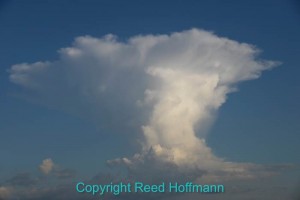
I love seeing those great towering cloud formations, and a little underexposure (darker) makes them more dramatic. Nikon D610, Sunny white balance, ISO 160, 1/800 at f/7.1, EV -0.7, 24-120mm lens at 65mm. Photo copyright Reed Hoffmann.

By switching the camera’s processing (Picture Control on Nikon) from Standard to Vivid, I could boost the contrast and saturation to add more drama to the scene.
Nikon D610, Sunny white balance, ISO 125, 1/200 at f/11, EV -0.3, 24-120mm lens at 65mm. Photo copyright Reed Hoffmann.
Much as I love clouds, though, there are only so many pictures you can shoot of them before they get boring. Which is a lot like sunsets – pretty sunsets are a dime a dozen. And that meant I needed to find something else to do with those clouds. I started by using some nearby trees to frame them. Then I noticed what was right in front of me – a field of tall grass and weeds.
All good pictures have a subject and a background. The best pictures use both of them effectively. Those grasses could be my subject, and the sky my background. Sadly, to get the framing I wanted, with the grass against the sky, I had to lie down. I’m normally happy to lie down, but on a hot summer evening that’s going to result in a lot itching. Oh well, sometimes we have to suffer for our art.
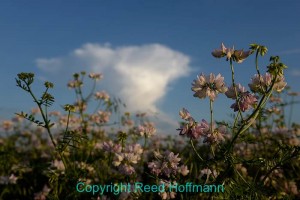
Lying down in the grass gave me a low enough angle to put these flowers against the sky.
Nikon D610, Sunny white balance, ISO 125, 1/320 at f/8, EV -0.7, 24-120mm lens at 38mm. Photo copyright Reed Hoffmann.
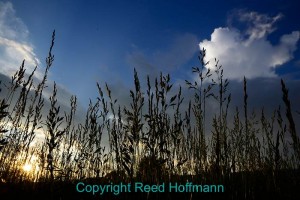
Putting the camera on the ground, shooting up through the grass towards the sun makes an interesting picture because it’s a view most people don’t see.
Nikon D610, Sunny white balance, ISO 125, 1/30 at f/22, EV -0.7, 24-120mm lens at 27mm. Photo copyright Reed Hoffmann.
Now that I had a close subject, I could also control the light on that subject. By changing my position (moving), I could change the light’s direction from front to side to back. Direct light (front) is usually pretty boring, so I wanted to shoot those grasses with the light coming from the side. Finding some light-colored flowers, I was able place them as my foreground subject, with the clouds and blue sky forming a nice background. After that I took a couple of steps into the field and turned toward the sun, placing the camera on the ground shooting up through the grasses. That let me shoot into the sun, whose brightness resulted in more underexposure, which brought out the rich blue sky and bright white clouds.
Done with the grass, I got in my car and went looking for something taller to use against the sky. Stopping in a nearby park, I found a small windmill. Perfect! Shooting from the side, though, meant you couldn’t see the windmill’s shape, and blades, very clearly. So I shifted position to shoot more from the front. Over the next twenty minutes I worked that windmill from different angles and with different lenses, close and far, wide-angle and telephoto, until the sun set and I lost my light. That was my cue head to call it a night.
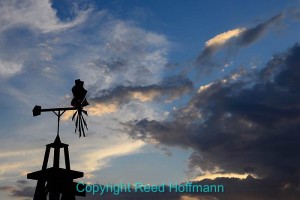
I preferred this view of the sky, but wanted to see more detail in the blades of the windmill, so needed to move to my right.
Nikon D610, Sunny white balance, ISO 125, 1/125 at f/8, EV 0.0, 24-120mm lens at 52mm. Photo copyright Reed Hoffmann.
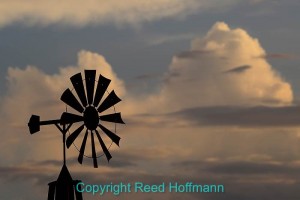
With the blades now clearly visible, I also made sure to frame the windmill in front of some white clouds to make sure the blades clearly stood out.
Nikon D610, Sunny white balance. ISO 125, 1/200 at f/8, EV 0.0, 70-300mm lens at 240mm. Photo copyright Reed Hoffmann.
While driving home, a lovely shade of cotton-candy pink slowly lit up the last clouds. Skidding to a stop by an open field, I jumped out to shoot those last few minutes of light and color. At moments like this it’s easy to get carried away and just start shooting, but that would be a mistake. With such dim light, I knew my shutter speed would be low, and I wasn’t using a tripod. So I took a moment to raise my ISO (which would result in a faster shutter speed), then made sure the VR switch (image stabilization) on my lens was “On.” With that combination and good technique (steady hands), I was able to get good sharp shots of that last bit of light. It was a great finish to a great evening.
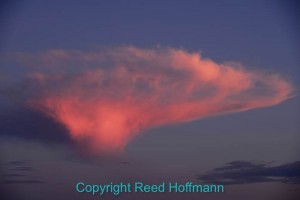
I loved the brilliant pink of this last bit of light, but it was pretty dim so I needed to raise my ISO. Doing that gave me a fast enough shutter speed to still get a sharp photo while hand-holding the camera.
Nikon D610, Sunny white balance, ISO 320, 1/50 at f/5.6, EV -1.0, 24-120mm lens at 82mm. Photo copyright Reed Hoffmann.
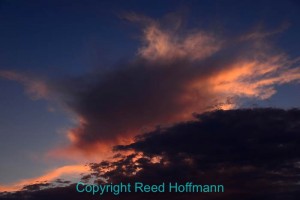
Shooting more towards brighter light I was able to lower my ISO again. Also, note that I used more underexposure, which helped maintain the rich pink color. At an EV of 0.0 that pink would look almost white. Nikon D610, Sunny white balance, ISO 200, 1/100 at f/5.6, EV -1.3, 24-120mm lens at 40mm. Photo copyright Reed Hoffmann.
As I said, I love clouds. I think they’re beautiful, and can make nice photos by themselves. But I also know that when you’ve got great clouds, you’ve got the potential for a better picture if you can just find the right subject to go with them. Of course, that’s true with most photography, isn’t it? Trying to find the right subject to go with the right background. In this case, those great clouds made that a lot easier.

